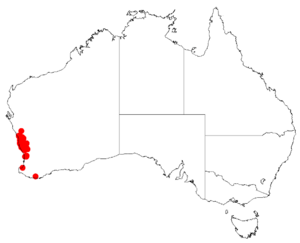Acacia auronitens facts for kids
Quick facts for kids Acacia auronitens |
|
|---|---|
| Scientific classification | |
| Genus: |
Acacia
|
| Species: |
auronitens
|
 |
|
| Acacia auronitens occurrence data from Australasian Virtual Herbarium | |
Acacia auronitens is a type of shrub that belongs to the Acacia family, often called wattles. It is special because it only grows in Western Australia.
What It Looks Like
This shrub usually spreads out and has many stems. It can grow to be about 0.1 to 0.5 metres (0 to 2 ft) tall and about 1 m (3 ft 3 in) wide. Its branches are covered in fine hairs and have small, thin leaf-like parts called stipules, which are 2 to 4 mm (0.079 to 0.157 in) long.
The leaves of this plant are actually not true leaves but flattened leaf stalks called phyllodes. They are green, stiff, and can be straight or slightly curved. These phyllodes are about 7 to 22 mm (0.28 to 0.87 in) long and 1 to 4 mm (0.039 to 0.157 in) wide. They are narrower at the bottom and have four main veins.
Acacia auronitens blooms from September to December. It produces bright yellow flowers that grow in round clusters. Each flower cluster has about 15 to 25 golden flowers. After the flowers, woody yellow seed pods form. These pods are narrow and oblong, about 45 mm (1.8 in) long and 4 to 9 mm (0.16 to 0.35 in) wide. Inside, the seeds are spotted and are about 3.7 mm (0.15 in) long.
Plant Family and Names
The plant was first officially described by a botanist named John Lindley in 1839. He wrote about it in his book A Sketch of the Vegetation of the Swan River Colony.
For a while, it was known by a different name, Racosperma auronitens, starting in 2003. But then, in 2006, it was moved back into the Acacia group. Another name it was sometimes called is Acacia aureonitens.
There are two known types of this plant:
- A. auronitens var. auronitens
- A. auronitens var. mollis
Where It Grows
This plant is found naturally in the Wheatbelt and Mid West areas of Western Australia. You can find it growing between places like Eneabba, Mingenew, and Perth.
It likes to grow on flat plains and hill slopes. It prefers sandy soils that contain gravel and a type of rock called laterite. It is often part of shrubland or heathland plant communities.

